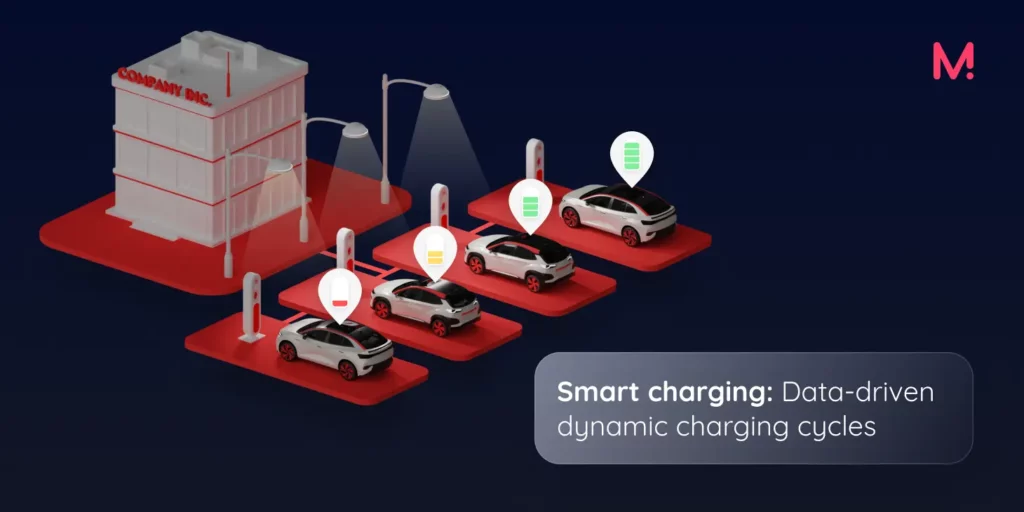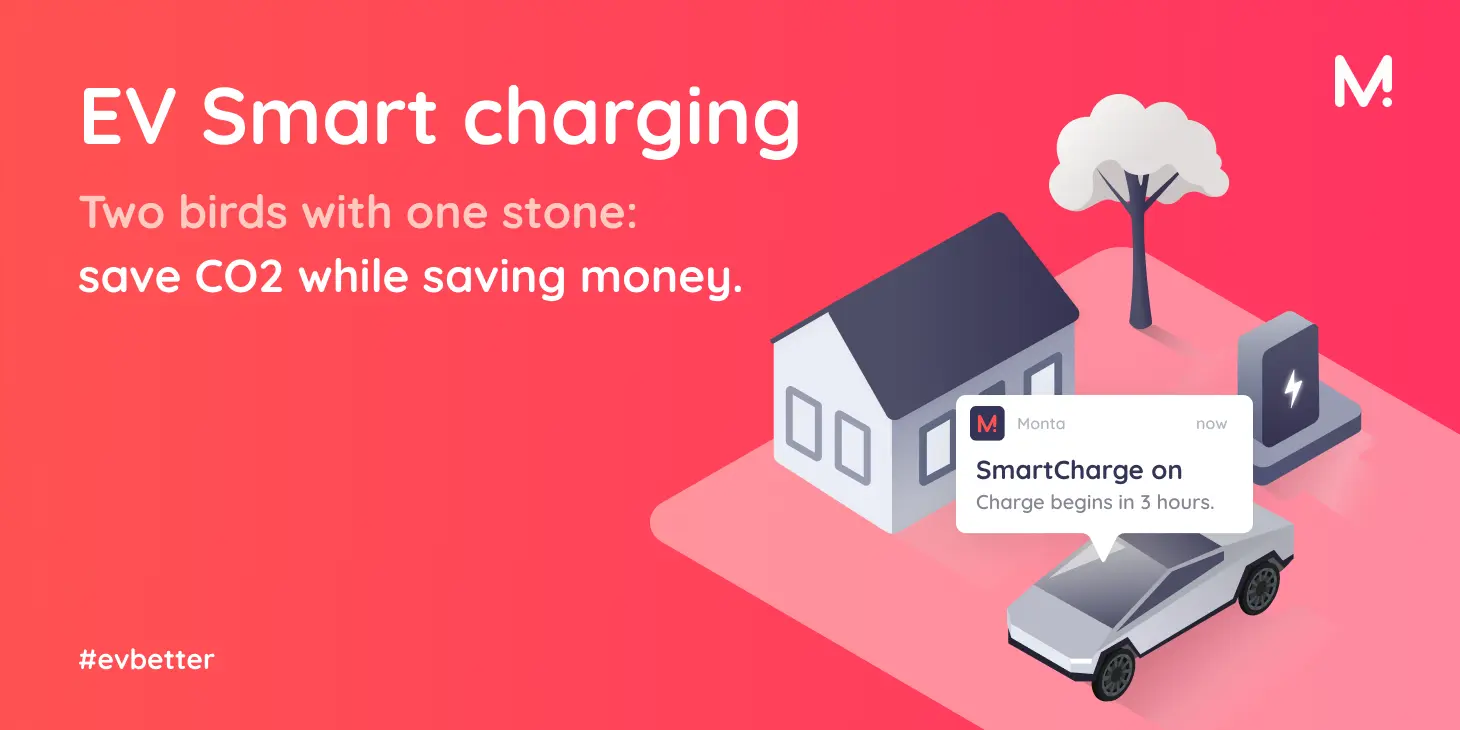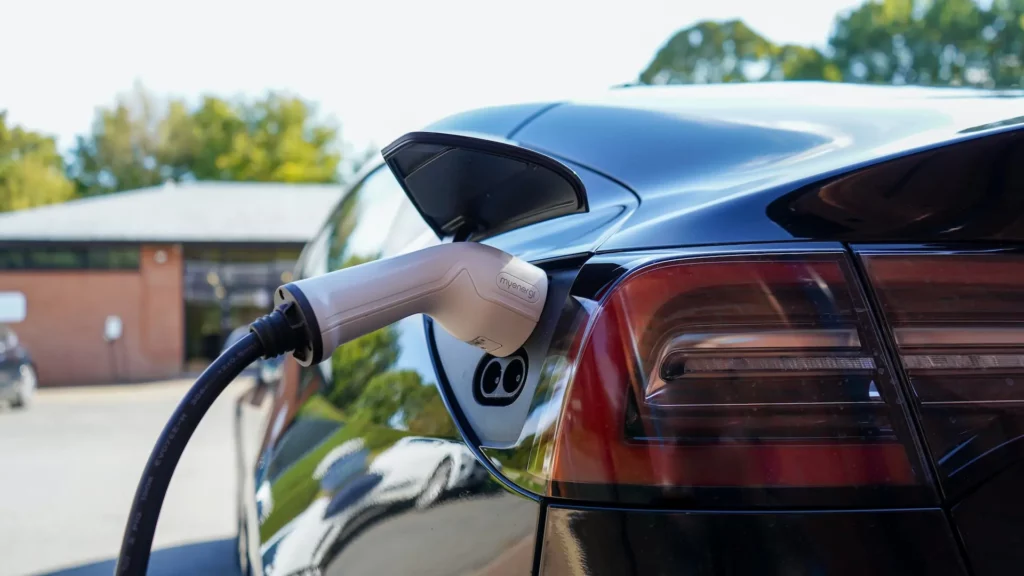What is Smart EV Charging and how does it work?
EV Smart Charging refers to a system that enables electric vehicle owners to charge their electric cars more efficiently and cost-effectively.
The system uses data from the grid and the EV owner's usage patterns to optimise the charging process, reducing the overall cost of charging the EV by understanding when the charge should take place to check all boxes: low price, time to use the car, needed charging breaks.
Like that, the entire charging cycle becomes more dynamic and more data-oriented paving the path for lower energy consumption.
All data is automatically uploaded and stored in the cloud allowing for continuous reiterations of features and processes depending on the needs of the EV owners. Therefore, regardless of whether you are an EV driver or a charging provider you can always keep up with whatever the future unfolds.

On the contrary, traditional EV chargers are unable to share data between them, your car, and the grid making the entire charging experience more fragmented, more energy-demanding and of course, much more expensive.
That being said, it is no surprise that so much attention has lately been invested in smart EV charging solutions and the development of new regulations concering them.
Smart EV Charging: From basic to advanced
Smart Charging isn't an "either or" state. Even if you are still relying on traditional EV chargers, there is room for improvement and for finding more efficient ways to charge your electric vehicle.
In a nutshell, here are the five steps towards a Smart Charging experience from basic to fully advanced:
1. Are you still using an old (non-smart) charge point?
There is still a smart way to charge your electric vehicle! All you have to do is plugging your electric car to the charging point manually during off-peak hours.
2. Plugging your EV manually can sometimes be inconvenient or even annoying.
That's why, you might want to look for electric vehicles that allow you to schedule in advance the time you want them to charge.
In that manner, you can still take advantage of off-peak hours despite the fact that you don't have access to a smart charge point.
3. If you have the opportunity to use a smart charge point, things get much simpler.
More specifically, it is highly probable that your smart charge point is supported by an app that will help you plan when your electric vehicle should charge outside of peak hours or on the basis of renewable energy availability. A charge point management software like Monta integrates with over 350 smart charging models, from reputable brands like Siemens, Easee, Zaptec, ABB and others.
4. Relying on an EV tariffs could also be a beneficial option for you.
By doing that, you allow the energy supplier of your choice to monitor when the best time for charging your vehicle is and remotely manage your charging events.
5. The last step is still under development but it is part of the Smart Charging experience of the future.
The "vehicle to everything" is seen as the next step in EV charging, as it allows other entities (e.g. your home or any other type of building) to benefit from any additional energy of your Electric Vehicle battery.
Learn more: How Smart Charging works with Monta
The benefits of Smart EV Charging

Smart EV Charging, in essence, just means that the charge point is connected to the Internet, enabling it to be remotely controlled by a software provider, such as Monta.
It helps optimise the charging process, reducing the overall cost of charging the EV.
There are several benefits for EV drivers, businesses and hardware manufacturers or resellers:
How can an EV driver benefit from Smart Charging?
We know well that being always on your toes about finding the right time window for charging your electric vehicle can be tiring.
This is why Smart Electric Vehicle Charging can make a difference, as it will allow you, as an EV driver, to enjoy a number of benefits:
- Reduced overall cost of charging your EV
- More efficient use of electricity (i.e. less wasted power)
- Avoidance of "peak demand" charges from your utility company
- Increased convenience (e.g. being able to set a charging schedule that works for your lifestyle)
Benefits of Smart Charging to businesses
Smart Charging isn't beneficial only for electric car drivers. Businesses have a lot to earn from it, as well.
Regardless of your type of business, Smart EV Charging can provide you with the following:
- Full and automated control of your charge points
- Schedule private, semi-public or public access to your charge points
- Custom pricing for employees, customers, guests, etc.
- Plan price changes or opt for dynamic spot pricing for peace of mind
- Open up your charge points for public or semi-public access for additional income
- Hassle-free payments
- Better monitoring of your consumption
Learn more: The charging solution for the workplaces of tomorrow
What can partners gain from Smart EV Charging?
If you are after an intuitive end-to-end EV charging experience, then this is again the single future-proof way for you. Thanks to Smart EV Charing, you will be able to:
- Scale your business faster
- Gain full and intuitive control of smart charging stations
- Set automated rules for private, semi-public or public access for individual chargers or entires sites
- Dynamically adjust pricing based on your own preferences: different times or groups of drivers, static or following the spot price of energy
- Automate and reduce maintenance needs
- Increase charge point availability
How to get started with EV Smart Charging

Diving into Smart EV Charging might feel like an overwhelming task. However, it is much simpler than you think if you have the right strategy in place:
Start from the basics
First things first, you need to make sure that all the prerequisites for a smooth electric vehicles smart sharging process are in place.
For instance, you have to decide where your smart charge point will be installed. Is it easy to locate?
Do you have an off-street parking spot to do it? Is it easy to access by EV drivers?
And what about connectivity? Remember that a smart charger relies on Wi-Fi or 3G/4G/5G connection to receive and share data.
Find the right smart charge point for you
Now that the fundamentals are in place, it's time to start looking for the right charge point.
Charge points can be either tethered or untethered. In simple words, a smart charge point can either have a cable permanently attached to it or not.
There are a number of different models in the market, so be sure to do your research to find one that meets your needs. Monta offers support for over 350 smart chargers, covering a wide selection of needs and budgets.
Use the right EV charging management app
Once you have a smart charge point, the next step is to download and install a charge point management app like Monta. It is free for charging at home, and allows EV drivers to get complete control of their charging experience. You can download Monta from Google Play store or the Apple App store.
It will allow you to connect your charger to the Internet in an easy and intuitive way, and configure it to work with your specific EV and charging schedule.
The most important Smart Charging features
As you dig deeper into EV charging, you might find yourself confused as to what you need to keep an eye on if you want to intelligently schedule your EV charges to save money and reduce your environmental footprint.
To save you the trouble, we present below three of the most crucial smart EV charging features you should know about:
Load balancing
Load balancing, also known as power sharing, describes the process of equally distributing the available electric power across the number of EVs that are linked to the grid.
As a business owner or a fleet operator, relying on load balancing is your best bet for maintaining the stability of the grid while ensuring that you are meeting energy demand. In simple words, not only energy efficiency is ensured but all the vehicles connected to your network get the service they need, too.
Peak shaving/power boost
Peak shaving (or power boost) is another important feature, when it comes to smart EV charging. It ensures that your power usage never goes beyond the available power capacity of your home or business.
In the case that the charging of your electric vehicle consumes more energy than what the power grid can afford, the system has the ability to automatically either pause the charging session or reduce the amount of energy dedicated to the charging event.
Like that, you avoid extra costs and potential power interruptions.
Dynamic load management
Dynamic load management (DLM) is a combination of what peak shaving and load balancing offer. It can be extremely beneficial for buildings and businesses with several charge points which deal with numerous electric vehicles on a daily basis.
In a sentence, dynamic load management ensures that charging sessions don't overcome the maximum charging capacity of the local electric network, while at the same time allowing for the most efficient distribution of the available power across the different vehicles which are in the process of charging.
This system makes it easier to keep your electricity expenses under control and helps you avoid costly upgrades of EV charging infrastructure.
Listen to the data and stay on top of your energy consumption
Once everything is up and running, you will soon start seeing the benefit of this new data-driven approach around EV charging.
Just by monitoring the app on your smartphone, you will be able to monitor whether everything works as it should and act quickly if a problem emerges.
Smart EV charging infrastructure in commercial and industrial buildings
As the adoption of electric vehicles expands, the owners or operators of commercial and industrial buildings are facing the need to provide the people who work or shop there with the option of charging their EVs. This can also be the case for people who live in a big appartment block.
With the right EV charging infrastructure in place, this new wave of EV adoption can both generate great revenue opportunities and upgrade the quality of living in the local area.
Building owners have the option to build their own charge point network, lease and make use of the charge point equipment or simply rent the space to a charge point operator. Regardless of which strategy they follow, relying on smart EV charging can take the operating cost down, ensure the stability of the grid and contribute to a lower carbon footprint.
In other words, investing in EV charging infrastructure might be less demanding than many building owners think. And to make things even better, it can also result in significant tax deductions thanks to your active contribution to CO2 reduction.
UK smart charging legislation: A quick introduction

The new UK Smart Charging regulations just came into force in 2022.
One of the main goals behind this new legislative initiative was the standardisation of all EV charging stations used in the United Kingdom.
In that way, the British government hopes that it will increase charging behaviour consistency and control electricity demand on the power grid more effectively.
The main points to keep in mind
In short, all new devices sold by charge points sellers should be able to support the following features:
- Charging during high-demand hours should be disabled by default.
- A randomised delay function should be introduced.
- Stronger focus on safety.
- The charging cycle should not be interrupted even if the charge point loses access to a communications network.
- Provide owners of electric vehicles with a detailed measuring system which will give them full overview of the amount of electricity used as well as the duration of the charging session.
Learn more and be prepared
It quickly becomes evident that the new Smart Charging legislation introduced by the British government is an ambitious plan which in the long run could optimize energy consumption, keep electricity prices under control and bring UK to a greener path.
If you live in the United Kingdom and want to find out more about the new regulations, we invite you to read our detailed guide on the topic!
Frequently asked questions
Smart EV Charging can in the beginning be quite confusing. To make things simpler, we have prepared below a list with some of the most common questions:
What is the difference between Smart Charging and normal EV Charging?
Smart Charging refers to a system that enables EV owners to charge their electric vehicles more efficiently and cost-effectively.
The system uses data from the energy grid and the EV owner's usage patterns to optimize the charging process, thereby reducing the overall cost of charging your electric vehicle(s).
What is the difference between smart charging and fast charging?
They might sound similar but they don't serve the same purpose. Fast EV charging focuses on the process of charging an electric battery at the quickest rate possible, without necessarily taking into account the needs of other electric vehicles connected to the grid.
As far as smart EV charging is concerned, the goal is the most cost- and energy-effective charging possible of the vehicle(s) connected to the grid. For instance, a smart charging system can even pause a charging session if in that way it could protect the stability of the grid.
How much does Smart Charging cost?
The cost of Smart Charging will vary depending on the specific management system you choose to set up and use.
Be sure to do your research to find a system that meets your needs and budget. For example, Monta's software is completely free for private users charging their own electric vehicles.
How do I get started with EV Smart Charging?
If you're interested in using Smart EV Charging, the first step is to purchase a smart charge point.
There are a number of different models on the market, so be sure to do your research to find one that meets your needs.
It's worth noting that Monta integrates with any hardware brand.
Once you have a smart charge point, the next step is to download and install an app like Monta, to get access to the smart charging capatiblities built into your charge point.
Monta will allow you to connect your charger to the internet and configure it to work with your specific car brand and preferred charging schedule.
What types of Electric Vehicles can use Smart Charging?
Smart Charging is compatible with all electric car models.
Is Smart Charging only available in certain countries?
Smart Charging is currently available anywhere, you just need your charge point to be connected to the Internet.
Do car chargers have to be smart?
In certain places like the UK, it is required that all new charge points support certain features that make them smarter, more cost-efficient and all in all standardised.
Depending on the country that you live in, the regulations might differ.
However, it is strongly recommended that you rely on smart chargers, as it is the most friendly option both for your wallet and the environment.
Is a smart EV charger worth it?
The short answer is yes! Smart EV chargers can help you use the available power much more efficiently and save money regardless of whether you are an EV driver, a fleet manager or a property owner.
Does Monta support Smart Charging?
Monta has been developed to support Smart Charging technology since the very beginning.
We encourage all users to download our app (it's free!) and see how the smart charging option can help them gain full overview of their vehicle's charging cycle.
How can Monta help you?
Making the EV charging experience smarter and hassle-free has been a priority for Monta since day one.
Since June 30th, we have also disabled peak charging as a default and introduced a randomised delay at the start of each charge via our software for new charge points connected to our platform.
We integrate with over 400+ charge point models, so if your charge point uses Monta you can have peace of mind that all your charges are smart, green and cost-efficient.
Try out the smart charging capabilities today by downloading the Monta app. It's free!

